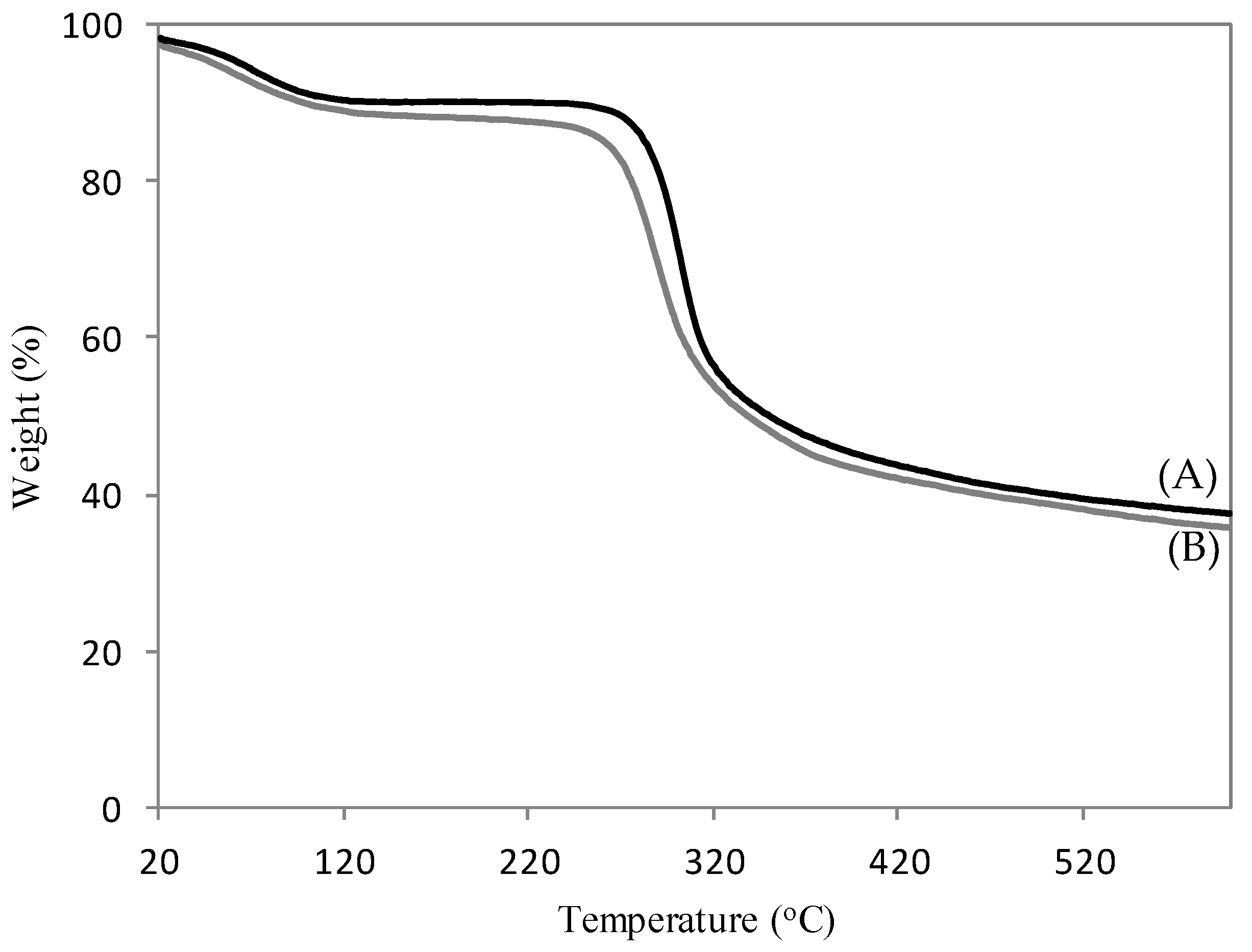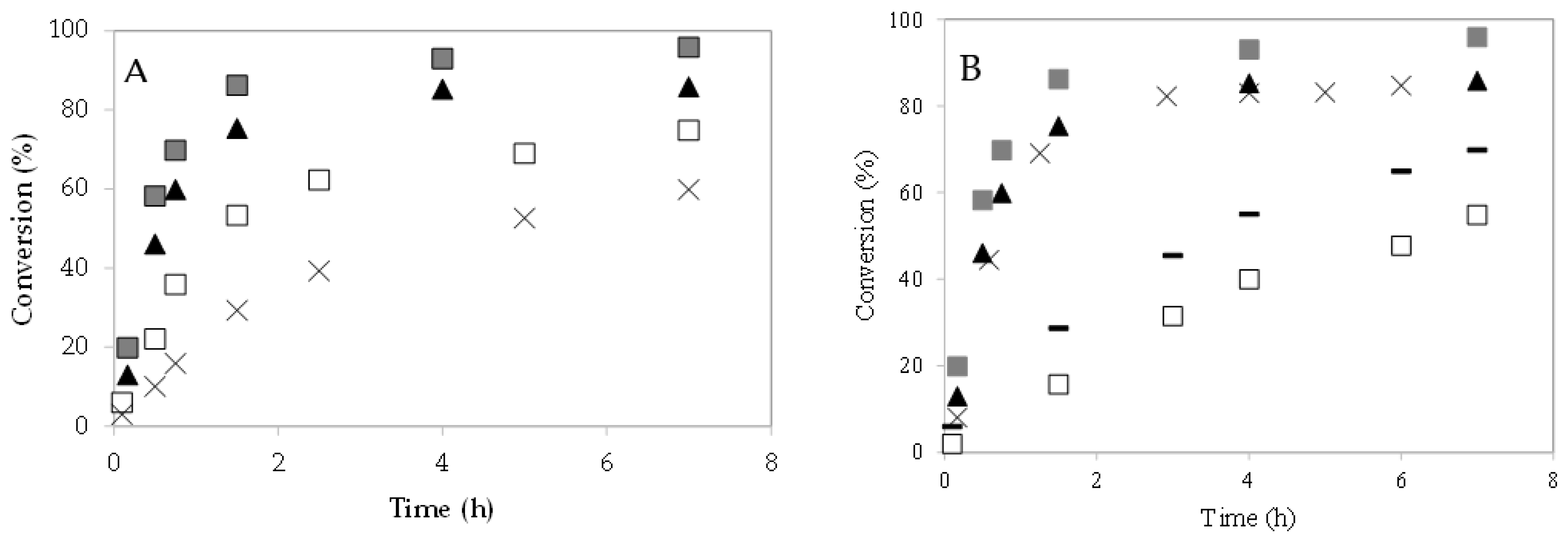Chitosan with Sulfonic Groups: A Catalyst for the Esterification of Caprylic Acid with Methanol
Abstract
:1. Introduction
2. Materials and Methods
2.1. Catalysts Preparation
2.2. Catalyst Characterization
2.3. Catalytic Experiments
2.4. Determination of Kinetic Constants, k (min−1)
3. Results and Discussion
3.1. Catalytic Experiments
3.2. Effect of Catalyst Loading
3.3. Effect of Molar Ratio Alcohol to Caprylic Acid
3.4. Effect of the Alcohol Nature and Temperature
3.5. Catalyst Stability and Reusability
4. Conclusions
Author Contributions
Funding
Institutional Review Board Statement
Informed Consent Statement
Data Availability Statement
Conflicts of Interest
References
- Avhad, M.R.; Marchettin, J.M. A review on recent advancement in catalytic materials for biodiesel production. Renew. Sustain. Energy Rev. 2015, 50, 696–718. [Google Scholar] [CrossRef]
- Lotero, E.; Liu, Y.; Lopez, D.E.; Suwannakarn, K.; Bruce, A.D.A.; Goodwin, J.J.G. Synthesis of Biodiesel via Acid Catalysis. Ind. Eng. Chem. Res. 2005, 44, 5353–5363. [Google Scholar] [CrossRef]
- Narasimhan, M.; Chandrasekaran, M.; Govindasamy, S.; Aravamudhan, A. Heterogeneous nanocatalysts for sustainable biodiesel production: A review. J. Environ. Chem. Eng. 2020, 9, 104876. [Google Scholar] [CrossRef]
- Batalha, D.C.; da Silva, M.J. Biodiesel production over niobium-containing catalysts: A review. Energies 2021, 14, 5506. [Google Scholar] [CrossRef]
- Caetano, C.; Guerreiro, L.; Fonseca, I.; Ramos, A.; Vital, J.; Castanheiro, J. Esterification of fatty acids to biodiesel over polymers with sulfonic acid groups. Appl. Catal. A Gen. 2009, 359, 41–46. [Google Scholar] [CrossRef]
- Doyle, A.M.; Albayati, T.M.; Abbas, A.S.; Alismaeel, Z.T. Biodiesel production by esterification of oleic acid over zeolite Y prepared from kaolin. Renew. Energy 2016, 97, 19–23. [Google Scholar]
- Singh, S.; Patel, A. 12-Tungstophosphoric acid supported on mesoporous molecular material: Synthesis, characterization and performance in biodiesel production. J. Clean. Prod. 2014, 72, 46–56. [Google Scholar] [CrossRef]
- Castanheiro, J.E.; Fonseca, I.M.; Ramos, A.M.; Vital, J. Tungstophosphoric acid immobilised in SBA-15 as an efficient hetero-geneous acid catalyst for the conversion of terpenes and free fatty acids. Micropor. Mesopor. Mater. 2017, 249, 16–24. [Google Scholar] [CrossRef] [Green Version]
- Patel, A.; Brahmkhatri, V.; Singh, N. Biodiesel production by esterification of free fatty acid over sulfated zirconia. Renew. Energy 2013, 51, 227–233. [Google Scholar] [CrossRef]
- Rezende, M.J.; Pinto, A.C. Esterification of fatty acids using acid-activated Brazilian smectite natural clay as a catalyst. Renew. Energy 2016, 92, 171–177. [Google Scholar] [CrossRef]
- Lou, W.-Y.; Zong, M.-H.; Duan, Z.-Q. Efficient production of biodiesel from high free fatty acid-containing waste oils using various carbohydrate-derived solid acid catalysts. Bioresour. Technol. 2008, 99, 8752–8758. [Google Scholar] [CrossRef]
- Guibal, E. Heterogeneous catalysis on chitosan-based materials: A review. Prog. Polym. Sci. 2005, 30, 71–109. [Google Scholar] [CrossRef]
- Kadib, A.E. Chitosan as a Sustainable Organocatalyst: A Concise Overview. ChemSusChem 2015, 8, 217–244. [Google Scholar] [CrossRef]
- Meninno, S. Valorization of Waste: Sustainable Organocatalysts from Renewable Resources. ChemSusChem 2019, 13, 439–468. [Google Scholar] [CrossRef]
- Aranaz, I.; Alcántara, A.R.; Civera, M.C.; Arias, C.; Elorza, B.; Caballero, A.H.; Acosta, N. Chitosan: An Overview of Its Properties and Applications. Polymers 2021, 13, 3256. [Google Scholar] [CrossRef]
- Khan, K.; Siddiqui, Z.N. An efficient synthesis of tri- and tetrasubstituted imidazoles from benzils using functionalized chi-tosan as biodegradable solid acid catalyst. Ind. Eng. Chem. Res. 2015, 54, 6611–6618. [Google Scholar] [CrossRef]
- Caetano, C.; Caiado, M.; Farinha, J.; Fonseca, I.M.F.L.; Ramos, A.; Vital, J.; Castanheiro, J. Esterification of free fatty acids over chitosan with sulfonic acid groups. Chem. Eng. J. 2013, 230, 567–572. [Google Scholar] [CrossRef]
- Unlu, D.; Hilmioglu, N.D. Fuel bioadditive production by chitosan/sulfosuccinic acid catalytic membrane. Energy Sources Part A Recover. Util. Environ. Eff. 2016, 38, 3606–3611. [Google Scholar] [CrossRef]
- Liu, B.; Jiang, P.; Zhang, P.; Bian, G.; Li, M. Preparation and characterization of SO42−/FexAl1−xPO4 solid acid catalysts for caprylic acid esterification. Catal. Commun. 2017, 99, 49–52. [Google Scholar] [CrossRef]
- Mohammadi, R.; Kassaee, M.Z. Sulfochitosan encapsulated nano-Fe3O4 as an efficient and reusable magnetic catalyst for green synthesis of 2-amino-4H-chromen-4-ylphosphonates. J. Mol. Cat. A Chem. 2013, 380, 152–158. [Google Scholar] [CrossRef]
- Srilatha, K.; Lingaiah, N.; Prasad, P.S.S.; Devi, B.L.A.P.; Prasad, R.B.N.; Venkateswar, S. Influence of Carbon Chain Length and Unsaturation on the Esterification Activity of Fatty Acids on Nb2O5 Catalyst. Ind. Eng. Chem. Res. 2009, 48, 10816–10819. [Google Scholar] [CrossRef]
- Bosco, S.M.D.; Gonçalves, M.; Figueiredo, F.C.A.; Galhardo, T.; Carvalho, W.A. Sulfated pillared clay as catalyst in glycerol esterification with caprylic acid. Waste Biomass Valor. 2016, 7, 1279–1288. [Google Scholar] [CrossRef]
- Pessoa Junior, W.A.G.; Takeno, M.L.; Nobre, F.X.; Barros, S.S.; Sá, I.S.C.; Silva, E.P.; Manzato, L.; Iglauer, S.; de Freitas, F.A. Application of water treatment sludge as a low-cost and eco-friendly catalyst in the biodiesel production via fatty acids ester-ification: Process optimization. Energy 2020, 213, 118824. [Google Scholar] [CrossRef]
- Rhim, J.-W.; Park, H.B.; Lee, C.S.; Jun, J.H.; Kim, D.S.; Lee, Y.M. Crosslinked poly(vinyl alcohol) membranes containing sul-fonic acid group: Proton and sulphur transport through membranes. J. Memb. Sci. 2004, 238, 143–151. [Google Scholar] [CrossRef]
- Xiang, Y.; Yang, M.; Guo, Z.; Cui, Z. Alternatively chitosan sulfate blending membrane as methanol-blocking polymer electrolyte membrane for direct methanol fuel cell. J. Membr. Sci. 2009, 337, 318–323. [Google Scholar] [CrossRef]
- Sreeprasanth, P.; Srivastava, R.; Srinivas, D.; Ratnasamy, P. Hydrophobic, solid acid catalysts for production of biofuels and lubricants. Appl. Catal. A Gen. 2006, 314, 148–159. [Google Scholar] [CrossRef]
- Mendonça, I.M.; Paes, O.A.R.L.; Maia, P.J.S.; Souza, M.P.; Almeida, R.A.; Silva, C.C.; Duvoisin, S., Jr.; de Freitas, F.A. New heterogeneous catalyst for biodiesel production from waste tucumã peels (Astrocaryum aculeatum Meyer): Parameters optimization study. Renew Energy 2019, 130, 103–110. [Google Scholar] [CrossRef]




 ) 1–CH–SO3H; (◯) 2-CH–SO3H; (☐) 3–CH–H; (▲) 4–CH–SO3H; (×) 5–CH–SO3H; (B) initial activities taken as the maximum observed reaction rate and k (min−1). Reaction conditions: catalyst amount (0.2 g); temperature (60 °C), molar ratio caprylic acid to methanol (1:95).
) 1–CH–SO3H; (◯) 2-CH–SO3H; (☐) 3–CH–H; (▲) 4–CH–SO3H; (×) 5–CH–SO3H; (B) initial activities taken as the maximum observed reaction rate and k (min−1). Reaction conditions: catalyst amount (0.2 g); temperature (60 °C), molar ratio caprylic acid to methanol (1:95).
 ) 1–CH–SO3H; (◯) 2-CH–SO3H; (☐) 3–CH–H; (▲) 4–CH–SO3H; (×) 5–CH–SO3H; (B) initial activities taken as the maximum observed reaction rate and k (min−1). Reaction conditions: catalyst amount (0.2 g); temperature (60 °C), molar ratio caprylic acid to methanol (1:95).
) 1–CH–SO3H; (◯) 2-CH–SO3H; (☐) 3–CH–H; (▲) 4–CH–SO3H; (×) 5–CH–SO3H; (B) initial activities taken as the maximum observed reaction rate and k (min−1). Reaction conditions: catalyst amount (0.2 g); temperature (60 °C), molar ratio caprylic acid to methanol (1:95).
 ) m = 0.3 g;. (B) effect of molar ratio of alcohol to caprylic acid. Conversion (%) versus time (h): (☐) 1:15 (m = 0.2 g); (×) 1:63 (m = 0.2 g); (▲) 1:95 (m = 0.2 g); (−) 1:15 (m = 0.3 g); (
) m = 0.3 g;. (B) effect of molar ratio of alcohol to caprylic acid. Conversion (%) versus time (h): (☐) 1:15 (m = 0.2 g); (×) 1:63 (m = 0.2 g); (▲) 1:95 (m = 0.2 g); (−) 1:15 (m = 0.3 g); (  ) 1:95 (m = 0.3 g).
) 1:95 (m = 0.3 g).
 ) m = 0.3 g;. (B) effect of molar ratio of alcohol to caprylic acid. Conversion (%) versus time (h): (☐) 1:15 (m = 0.2 g); (×) 1:63 (m = 0.2 g); (▲) 1:95 (m = 0.2 g); (−) 1:15 (m = 0.3 g); (
) m = 0.3 g;. (B) effect of molar ratio of alcohol to caprylic acid. Conversion (%) versus time (h): (☐) 1:15 (m = 0.2 g); (×) 1:63 (m = 0.2 g); (▲) 1:95 (m = 0.2 g); (−) 1:15 (m = 0.3 g); (  ) 1:95 (m = 0.3 g).
) 1:95 (m = 0.3 g).
 ) reaction with methanol at 60 °C (m = 0.3 g); (☐) reaction with ethanol at 60 °C (m = 0.2 g); (
) reaction with methanol at 60 °C (m = 0.3 g); (☐) reaction with ethanol at 60 °C (m = 0.2 g); (  ) reaction with ethanol at 60 °C (m = 0.3 g); (×) reaction with ethanol at 80 °C (m = 0.2 g); (−) reaction with ethanol at 80 °C (m = 0.3 g); (B) stability studies of the 4–CH–SO3H catalyst on esterification of caprylic acid with methanol.
) reaction with ethanol at 60 °C (m = 0.3 g); (×) reaction with ethanol at 80 °C (m = 0.2 g); (−) reaction with ethanol at 80 °C (m = 0.3 g); (B) stability studies of the 4–CH–SO3H catalyst on esterification of caprylic acid with methanol.
 ) reaction with methanol at 60 °C (m = 0.3 g); (☐) reaction with ethanol at 60 °C (m = 0.2 g); (
) reaction with methanol at 60 °C (m = 0.3 g); (☐) reaction with ethanol at 60 °C (m = 0.2 g); (  ) reaction with ethanol at 60 °C (m = 0.3 g); (×) reaction with ethanol at 80 °C (m = 0.2 g); (−) reaction with ethanol at 80 °C (m = 0.3 g); (B) stability studies of the 4–CH–SO3H catalyst on esterification of caprylic acid with methanol.
) reaction with ethanol at 60 °C (m = 0.3 g); (×) reaction with ethanol at 80 °C (m = 0.2 g); (−) reaction with ethanol at 80 °C (m = 0.3 g); (B) stability studies of the 4–CH–SO3H catalyst on esterification of caprylic acid with methanol.
| Sample | Acid Capacities | Methanol Swelling c (%) | Water Swelling d (%) | |
|---|---|---|---|---|
| Titration a | Scontent b | |||
| CH | 0.40 | − | 0.93 | 1.61 |
| 1–CH–SO3H | 1.28 | 1.30 | 0.063 | 1.53 |
| 2–CH–SO3H | 2.05 | 2.09 | 0.032 | 1.44 |
| 3–CH–SO3H | 3.09 | 3.11 | 0.022 | 1.29 |
| 4–CH–SO3H | 3.19 3.17 f | 3.21 3.19 f | 0.015 (0.007 e) | 1.09 |
| 5–CH–SO3H | 3.25 | 3.27 | 0.009 | 0.77 |
| Catalyst | Temperature (°C) | Catalyst Amount (g) | Molar Ratio Caprylic Acid: Acohol | % Conversion (Time) | Reference |
|---|---|---|---|---|---|
| 4–CH–SO3H | 60 | 15% wt. | 1:95 a | 75 (90 min) | Present work |
| SO42−/Fe0.08Al0.92PO4 | 75 | 1.5% wt. | 1:6 b | 90 (240 min) | [19] |
| Nb2O5 | 65 | 15% wt. | 1:14 a | 95 (180 min) | [21] |
| WTS3M | 100 | 5% wt. | 1:15 a | 98 (180 min) | [23] |
Publisher’s Note: MDPI stays neutral with regard to jurisdictional claims in published maps and institutional affiliations. |
© 2021 by the author. Licensee MDPI, Basel, Switzerland. This article is an open access article distributed under the terms and conditions of the Creative Commons Attribution (CC BY) license (https://creativecommons.org/licenses/by/4.0/).
Share and Cite
Castanheiro, J. Chitosan with Sulfonic Groups: A Catalyst for the Esterification of Caprylic Acid with Methanol. Polymers 2021, 13, 3924. https://doi.org/10.3390/polym13223924
Castanheiro J. Chitosan with Sulfonic Groups: A Catalyst for the Esterification of Caprylic Acid with Methanol. Polymers. 2021; 13(22):3924. https://doi.org/10.3390/polym13223924
Chicago/Turabian StyleCastanheiro, José. 2021. "Chitosan with Sulfonic Groups: A Catalyst for the Esterification of Caprylic Acid with Methanol" Polymers 13, no. 22: 3924. https://doi.org/10.3390/polym13223924






